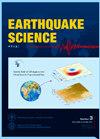Multi-parameter modeling and analysis of ground motion amplification in the Quaternary sedimentary basin of the Beijing-Tianjin-Hebei region
IF 4.1
4区 地球科学
Q3 Earth and Planetary Sciences
引用次数: 0
Abstract
Basin effect was first described following the analysis of seismic ground motion associated with the 1985 MW8.1 earthquake in Mexico. Basins affect the propagation of seismic waves through various mechanisms, and several unique phenomena, such as the basin edge effect, basin focusing effect, and basin-induced secondary waves, have been observed. Understanding and quantitatively predicting these phenomena are crucial for earthquake disaster reduction. Some pioneering studies in this field have proposed a quantitative relationship between the basin effect on ground motion and basin depth. Unfortunately, basin effect phenomena predicted using a model based only on basin depth exhibit large deviations from actual distributions, implying the severe shortcomings of single-parameter basin effect modeling. Quaternary sediments are thick and widely distributed in the Beijing-Tianjin-Hebei region. The seismic media inside and outside of this basin have significantly different physical properties, and the basin bottom forms an interface with strong seismic reflections. In this study, we established a three-dimensional structure model of the Quaternary sedimentary basin based on the velocity structure model of the North China Craton and used it to simulate the ground motion under a strong earthquake following the spectral element method, obtaining the spatial distribution characteristics of the ground motion amplification ratio throughout the basin. The back-propagation(BP) neural network algorithm was then introduced to establish a multi-parameter mathematical model for predicting ground motion amplification ratios, with the seismic source location, physical property ratio of the media inside and outside the basin, seismic wave frequency, and basin shape as the input parameters. We then examined the main factors influencing the amplification of seismic ground motion in basins based on the prediction results, and concluded that the main factors influencing the basin effect are basin shape and differences in the physical properties of media inside and outside the basin.
京津冀地区第四纪沉积盆地地震动放大多参数模拟与分析
在对1985年墨西哥MW8.1地震的地面运动分析之后,首次描述了盆地效应。盆地通过多种机制影响地震波的传播,并观测到盆地边缘效应、盆地聚焦效应和盆地次生波等独特现象。了解和定量预测这些现象对减少地震灾害至关重要。该领域的一些开创性研究已经提出了盆地对地面运动的影响与盆地深度之间的定量关系。遗憾的是,仅基于盆地深度的模型预测的盆地效应现象与实际分布存在较大偏差,这表明单参数盆地效应模型存在严重缺陷。京津冀地区第四纪沉积物厚度大、分布广。盆地内外地震介质物性差异明显,盆地底部形成强地震反射界面。本研究在华北克拉通速度结构模型的基础上,建立了第四纪沉积盆地三维结构模型,并运用谱元法模拟了强震作用下的地震动,得到了整个盆地地震动放大比的空间分布特征。以震源位置、盆内外介质物性比、地震波频率和盆地形状为输入参数,引入BP神经网络算法,建立了预测地震动放大比的多参数数学模型。基于预测结果,分析了影响盆地地震动放大的主要因素,认为影响盆地效应的主要因素是盆地形状和盆内外介质物性差异。
本文章由计算机程序翻译,如有差异,请以英文原文为准。
求助全文
约1分钟内获得全文
求助全文
来源期刊

Earthquake Science
GEOCHEMISTRY & GEOPHYSICS-
CiteScore
1.10
自引率
8.30%
发文量
42
审稿时长
3 months
期刊介绍:
Earthquake Science (EQS) aims to publish high-quality, original, peer-reviewed articles on earthquake-related research subjects. It is an English international journal sponsored by the Seismological Society of China and the Institute of Geophysics, China Earthquake Administration.
The topics include, but not limited to, the following
● Seismic sources of all kinds.
● Earth structure at all scales.
● Seismotectonics.
● New methods and theoretical seismology.
● Strong ground motion.
● Seismic phenomena of all kinds.
● Seismic hazards, earthquake forecasting and prediction.
● Seismic instrumentation.
● Significant recent or past seismic events.
● Documentation of recent seismic events or important observations.
● Descriptions of field deployments, new methods, and available software tools.
The types of manuscripts include the following. There is no length requirement, except for the Short Notes.
【Articles】 Original contributions that have not been published elsewhere.
【Short Notes】 Short papers of recent events or topics that warrant rapid peer reviews and publications. Limited to 4 publication pages.
【Rapid Communications】 Significant contributions that warrant rapid peer reviews and publications.
【Review Articles】Review articles are by invitation only. Please contact the editorial office and editors for possible proposals.
【Toolboxes】 Descriptions of novel numerical methods and associated computer codes.
【Data Products】 Documentation of datasets of various kinds that are interested to the community and available for open access (field data, processed data, synthetic data, or models).
【Opinions】Views on important topics and future directions in earthquake science.
【Comments and Replies】Commentaries on a recently published EQS paper is welcome. The authors of the paper commented will be invited to reply. Both the Comment and the Reply are subject to peer review.
 求助内容:
求助内容: 应助结果提醒方式:
应助结果提醒方式:


